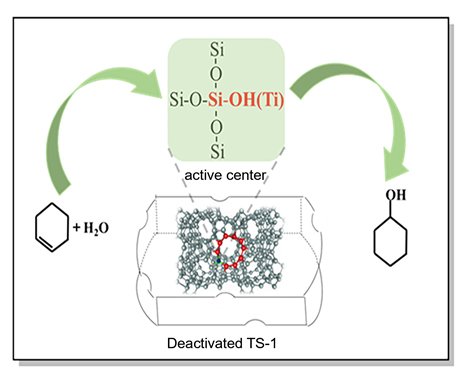[1] Guo, Z. W.; Jin, H. B.; Tong, Z. M. Chem. Prog. 2006, 25, 852(in Chinese). (郭志武, 靳海波, 佟泽民, 化工进展, 2006, 25, 852.)
[2] Hiroshi, F.; Fujinao, M.; Masao, K. JP02040334, 1990[Chem. Abstr. 1990, 112, 216297].
[3] Yang, X. D.; Wang, X. M.; Gao, S. B.; Wang, A. J. Acta Chim. Sinica 2017, 75, 479(in Chinese). (杨晓东, 王新苗, 高善彬, 王安杰, 化学学报, 2017, 75, 479.)
[4] Fang, W. J.; Xie, W. J.; Xing, Y.; Guo, Y. S.; Lin, R. S. Acta Chim. Sinica 2009, 67, 6(in Chinese). (方文军, 谢文杰, 邢燕, 郭永胜, 林瑞森, 化学学报, 2009, 67, 6.)
[5] Fukuoka, Y.; Mitsui, O. JP60104031A, 1985[Chem. Abstr. 1985, 103, 123067].
[6] Tojo, M.; Fukuoka, Y. JP61180735A, 1986[Chem. Abstr. 1986, 106, 17969].
[7] Wang, H.; Fan, W. B.; Li, Y. C.; Dong, M.; Li, J. F.; Wang, G. F.; Qin, Z. F.; Wang, J. G. Acta Chim. Sinica 2016, 74, 529(in Chinese). (王浩, 樊卫斌, 李艳春, 董梅, 李俊汾, 王国富, 秦张峰, 王建国, 化学学报, 2016, 74, 529.)
[8] Qiao, M. H.; Zong, B. N.; Cheng, S. J.; Zeng, Y.; Pei, Y.; Fan, K. N. Acta Chim. Sinica 2019, 77, 1054(in Chinese). (乔明华, 宗保宁, 成诗婕, 曾杨, 裴燕, 范康年, 化学学报, 2019, 77, 1054.)
[9] Taramasso, M.; Perego, G.; Notari, B. US 4410501A, 1983[Chem. Abstr. 1983, 95, 206272].
[10] Nijhuis, T. A.; Huizinga, B. J.; Makkee, M.; Moulijin, J. A. Ind. Eng. Chem. Res. 1997, 151, 355.
[11] Sun, B. Pet. Ref. Chem. Ind. 2005, 36, 54(in Chinese). (孙斌, 石油炼制与化工, 2005, 36, 54.)
[12] Ishida, H. Catal. Surv. Jpn. 1997, 1, 241.
[13] Su, J.; Xiong, G.; Zhou, J. C.; Liu, W. H.; Zhou, D. H.; Wang, G. R.; Wang, X. S.; Guo, H. C. J. Catal. 2012, 288, 1.
[14] Fang, X. Q.; Wang, Q.; Zheng, A. M.; Liu, Y. M.; Wang, Y. N.; Deng, X. J.; Wu, H. H.; Deng, F.; He, M. Y.; Wu, P. Catal. Sci. Techonol. 2012, 2, 2433.
[15] Wang, Y.; Liu, Y. M.; Li, X. H.; Wu, H. H.; He, M. Y.; Wu, P. J. Catal. 2009, 266, 258.
[16] Vayssilov, G. N. Catal. Rev. Sci. Eng. 1997, 39, 209.
[17] Blasco, T.; Camblor, M. A.; Corma, A. J. Am. Chem. Soc. 1993, 115, 11806.
[18] Notari, B. Catal. Today 1993, 18, 163.
[19] Liu, Z. F.; Davis, R. J. J. Phys. Chem. 1994, 98, 1253.
[20] Liu, Y. Q.; Li, Y. X.; Wu, W. Pet. Ref. Chem. Ind. 2002, 5, 41(in Chinese). (刘银乾, 李永祥, 吴巍, 石油炼制与化工, 2002, 5, 41.)
[21] Itoh, M.; Hattori, H.; Tanabe, K. J. Catal. 1974, 35, 225.
[22] Lin, L. F.; Qiu, C. F.; Zhuo, Z. X.; Zhang, D. W.; Zhao, S. F.; Wu, H. H.; Liu, Y. M.; He, M. Y. J. Catal. 2014, 309, 136.
[23] Lin, L. F.; Zhao, S. F.; Zhang, D. W.; Fan, H.; Liu, Y. M.; He, M. Y. ACS Catal. 2015, 5, 4048.
[24] Corma, A.; Orchillés, A. V. Micro. Meso. Mater. 2000, 35, 21.
[25] Emeis, C. A. J. Catal. 1993, 141, 347.
[26] Barzetti, T.; Selli, E.; Moscotti, D.; Forni, L. J. Chem. Soc., Faraday Trans. 1996, 92, 1401.
[27] Post, J. G.; Van Hooff, J. H. C. Zeolites 1984, 4, 9.
[28] Farneth, W. E.; Gorte, R. J. Chem. Rev. 1995, 95, 615.
[29] Al-Dughaither, A. S.; de Lasa, H. Ind. Eng. Chem. Res. 2014, 53, 15303.
[30] Wu, P.; Tatsumi, T.; Komatsu, T.; Yashima, T. J. Phys. Chem. B 2001, 105, 2897.
[31] Liu, H.; Lu, G. Z.; Guo, Y. L.; Guo, Y.; Wang, J. S. Catal. Today 2004, 93, 353.
[32] Qi, Y. Y.; Ye, C. B.; Zhuang, Z.; Xin, F. Micro. Meso. Mater. 2011, 142, 661.
[33] Wang, Y.; Liu, Y. M.; Li, X. H.; Wu, H. H.; He, M. Y.; Wu, P. J. Catal. 2009, 266, 258.
[34] Zhuo, Z. X.; Lin, L. F.; Deng, X. J.; Wang, Y. N.; Liu, Y. M. Chin. J. Catal. 2013, 34, 604.
[35] Tozzola, G.; Mantegazza, M. A.; Ranghino, G.; Petrini, G.; Bordiga, S.; Ricchiardi, G.; Lamberti, C.; Zulian, R.; Zecchina, A. J. Catal. 1998, 179, 64.
[36] Ricchiardi, G.; Damin, A.; Bordiga, S.; Lamberti, C.; Spano, G.; Rivetti, F.; Zecchina, A. J. Am. Chem. Soc. 2001, 123, 11409.
[37] Camblor, M. A.; Corma, A.; Pérez-Pariente, J. J. Chem. Soc., Chem. Commun. 1993, 557.
[38] Wang, D. Z.; Shu, X. T.; He, M. Y. Chin. J. Catal. 2002, 23, 503(in Chinese). (王殿中, 舒兴田, 何鸣元, 催化学报, 2002, 23, 503.)
[39] Zhao, G. L.; Teng, J. W.; Xie, Z. K.; Jin, W. Q.; Yang, W. M.; Chen, Q. L.; Tang, Y. J. Catal. 2007, 248, 29. |
